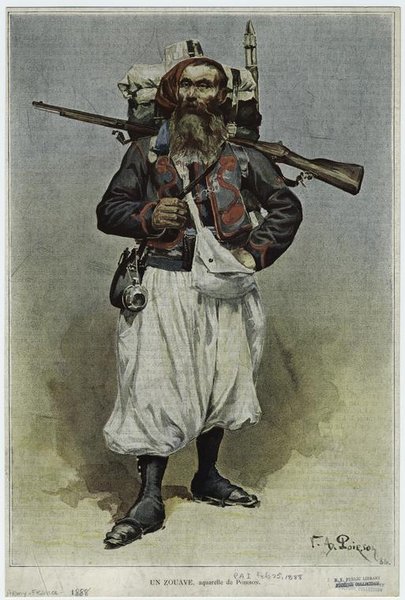Zouave Jacket Definition - Definition of Jackets for the Apparel Industry presented by Apparel Search
 Zouave was the name given to certain infantry regiments
in the French army, as well as to units in other armies
which imitated the dress or drill of the French zouaves.
Zouave was the name given to certain infantry regiments
in the French army, as well as to units in other armies
which imitated the dress or drill of the French zouaves.
French Zouaves
The corps was first raised in Algeria in 1831 with one and later two battalions, and recruited solely from the Zouaoua, a tribe of Berbers, dwelling in the mountains of the Jurjura range (see Kabyles). In 1838 a third battalion was raised, and the regiment thus formed was commanded by Lamoriciere. Shortly afterwards the formation of the Tirailleurs algeriens, the Turcos, as the corps for Muslim troops, changed the enlistment for the Zouave battalions, and they became a purely French body. Three regiments had been formed by 1852, and a fourth, the Zouaves of the Imperial Guard, in 1854. The Crimean War was the first service which the regiments saw outside Algeria. Their distinctive dress and dash made them well known outside France. After 1871 the Zouaves lost their status as an elite corps of volunteers and became mainly comprised of conscripts from the French settlers in Algeria and Tunisia doing their compulsory military service.
The four Zouave regiments of the French Army wore their traditional colorful dress during the early months of the First World War. The development of the machine gun, rapid fire artillery and improved small arms obliged them to adopt a plain khaki uniform from 1915 on. Between the wars the "oriental dress" of red fez, braided blue jackets and voluminous red trousers was still seen as off-duty dress for re-enlisted NCOs and other long service regulars in the Zouave regiments.
The Zouaves played a major role in the 1914-18 War but were less conspicuous in World War II. As predominately conscript units they did not serve in Indo-China between 1945 and 1954. They were however employed extensively during the Algerian War, before being finally disbanded in 1962 following Algerian independence. The traditions of the Zouave regiments are maintained at the present time by the French Army's Commando Training School.
Papal Zouaves
The Papal Zouaves were formed in defence of the Papal states by Lamoriciere in 1860. After the occupation of Rome by Victor Emmanuel in 1870, the Papal Zouaves served the government of National Defence in France during the Franco-Prussian War, and were disbanded after the entrance of German troops into Paris. They wore a similar style of uniform to that of the French Zouaves but in grey with red trim. A grey and red kepi was substitued for the North African fez.
American Zouaves
Several Zouave Regiments were organized from American soldiers who adopted the name and the North African inspired uniforms during the American Civil War. The Union army had Zouave regiments throughout the conflict, while the Confederates fielded only a handful of Zouave units. The most famous Union Zouave regiments were from New York: the 5th New York Volunteer Infantry, "Duryee's Zouaves", and the 11th New York Volunteer Infantry, 'Fire Zouaves.' The 11th New York was initially led by Col. Elmer E. Ellsworth until his death in 1861. The regiment was badly mauled during the First Battle of Bull Run in July 1861. The 5th New York was considered one of the elite units of the Army of the Potomac, and was only one of two volunteer regiments brigaded with regular division commanded by George Sykes. At the Second Battle of Bull Run, the 5th New York, along with another Zouave regiment, the 10th New York "National Zouaves", held off the flanking attack of James Longstreet's Corps for ten crucial minutes before it was overrun. The result was that the 5th New York suffered the highest percentage of casualties in the shortest amount of time of any unit in the Civil War (of 525 men, approximately 120 were killed and 330 were wounded in less than 10 minutes). From 1863 onward, Zouave uniforms were often used to reward Union army regiments for exceptional battlefield performance. Zouaves gradually vanished from the U.S. military in the 1870s and 1880s, as the militia system slowly transformed into the National Guard.
The Zouave uniform was quite elaborate, to the extent that it was unwieldy. Zouaves wore a fez with a colored tassel (usually yellow, blue, green, or red) and turban, a tight fitting short jacket without buttons, a wide ten-foot long sash, baggy pantaloons or "chasseur" trousers, white leggings, and a short leather cuff for the calf called jambieres. The sash was especially difficult to put on, often requiring the help of another Zouave. The Zouave uniform was especially suited for warm climates and rough terrain. The loose pantaloons allowed for greater freedom of movement than trousers, while the short jacket was much cooler than the long wool blouse worn by most armies of the time. One of the reasons for the small number of Zouave units in the U.S. and Europe was the expense of the specialized uniform over that of mass-produced uniforms of a single color/cut.Abraham Lincoln's son Willie had a Zouave doll. When the boy imagined that the doll would be court-martialed, Lincoln gave the doll a presidential pardon.
|
|
|
| The above article is licensed under the GNU Free Documentation License. From Wikipedia, the free encyclopedia (https://en.wikipedia.org/wiki/zouave). Modified by Apparel Search 1/15/06 |
 |
| Discussion boards are a great place to meet other members of the fashion industry, get advice, and share information. This forum was created to discuss the topic of this page. If you have questions, or information to improve this page, please join in the community discussion below. Please keep the communication on topic and for the purpose of education. |
|
|